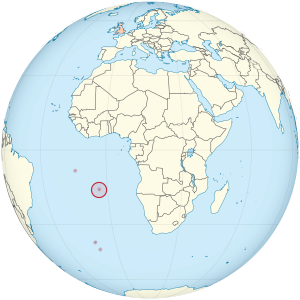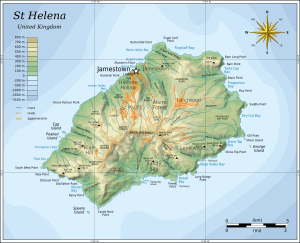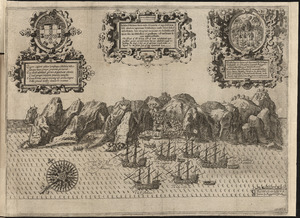Dutch invasion of Saint Helena facts for kids
Quick facts for kids Dutch invasion of Saint Helena |
|||||||
|---|---|---|---|---|---|---|---|
| Part of the Third Anglo-Dutch War | |||||||
 Location of Saint Helena |
|||||||
|
|||||||
| Belligerents | |||||||
| Commanders and leaders | |||||||
| Jacob de Gens | Anthony Beale | ||||||
In January 1673, the Dutch invaded Saint Helena, taking control of the island from the English East India Company (EIC). The Dutch had lived on the island before. But they left it for a new colony in what is now Cape Town. However, Cape Town was not a good port. So, the Dutch used the Third Anglo-Dutch War as a chance to take Saint Helena back. The EIC soldiers did not fight much.
The English governor, Anthony Beale, escaped to Brazil. He took some soldiers and enslaved people with him. He sent a small ship to tell others that the island was lost. This ship met a Royal Navy group led by Richard Munden. Munden decided to get the island back. In May, his team landed under Lieutenant Richard Keigwin. Munden's ships fired at the Dutch, who then gave up. Keigwin stayed on the island as the new governor. More soldiers were left to protect it. This invasion was the last time a foreign power took the island.
Island History
Saint Helena is an island in the South Atlantic Ocean. A Portuguese explorer named João da Nova found it in 1502. Over the next 100 years, English, Portuguese, and Dutch sailors visited the island.
Around 1645, the Dutch started a settlement there. But they left by 1651. They preferred their new settlement at Cape Town in Southern Africa.
In 1659, the English East India Company (EIC) arrived. They were sent by Oliver Cromwell, England's leader at the time. They built a fort called the Castle of St John. After 1660, the fort was renamed James Fort. This was to honor James, Duke of York. The nearby town became Jamestown. Saint Helena became very important for the East India Company. It was a good place for their ships to stop for supplies.
The Dutch Takeover
The Dutch found that Cape Town was not as good a harbor as Saint Helena. The Third Anglo-Dutch War (1672–1674) gave them a chance to get the island back. A Dutch Navy group, led by Jacob de Gens, left Cape Town in late 1672.
In January 1673, the Dutch landed at Lemon Valley. This was west of Jamestown. They tried to climb a steep valley. But English settlers pushed them back by throwing rocks. The Dutch got back on their ships. They landed further west. There, they defeated the English defenders and reached the high ground.
Some stories say that the English lost because of a betrayal. The English governor, Anthony Beale, damaged the island's cannons. He also ruined the gunpowder. He moved valuable items onto his ship. Then, he escaped to Colonial Brazil. The Dutch took control of the island. They put their own soldiers in the fort. They renamed it Good Fortune.
English Recapture
| Recapture of Saint Helena | |||||||
|---|---|---|---|---|---|---|---|
| Part of the Third Anglo-Dutch War | |||||||
 Relief map of Saint Helena |
|||||||
|
|||||||
| Belligerents | |||||||
| Commanders and leaders | |||||||
| Jacob de Gens | Richard Munden | ||||||
Governor Beale hired a small ship in Brazil. He sent some soldiers and enslaved people on it. Their job was to warn English ships that the island was lost. This ship met an English Royal Navy and EIC group. Captain Richard Munden led this group. He was on his way to help defend Saint Helena. Munden decided to take the island back, even without direct orders.
Munden sailed to Fisher's Valley. This was on the east side of the island. A stream there flowed down a 150-foot (46 m) high cliff. One of Beale's enslaved people, named Black Oliver, knew a way up this cliff. On May 4, after dark, he and some of Munden's men landed there. Lieutenant Richard Keigwin led them. One of Keigwin's men, named Tom, climbed first. He carried a rope to help pull up the others. The shouts of "hold fast, Tom!" led to this spot being called Hold Fast Tom today. The Dutch had no soldiers to guard this spot. So, Keigwin's group got to high ground. From there, they could see into the fort, making it easy to attack.
While Keigwin's group climbed, Munden sailed to the fort. He began to fire his ship's cannons at it. For a long time, Munden's single ship faced the fort's cannons alone. The Dutch gave up at 6 PM on May 5. This was before Keigwin's men even arrived. Munden learned that more Dutch ships were coming. So, he kept the Dutch flag flying on Sugar Loaf Hill. This was a trick to fool the Dutch ships. He was able to capture most of a group of ships that arrived in the port.
What Happened Next
The EIC sent more soldiers to Saint Helena. Later that year, they also created a local army. This army was made up of settlers to defend the island. The 1673 invasion was the last time a foreign power captured the island.
When Munden returned to England, he was made a knight for his actions. He continued to serve in the navy until he died in 1680. Keigwin stayed on the island as governor. He later moved to India. He became a high-ranking military and political leader. But he had problems with the EIC leaders and was called back. He led a rebellion against the EIC in December 1683. He became the unofficial governor of Bombay for almost a year. He gave up after being promised a pardon. He later commanded a ship called Assistance. He died in 1690 during a fight in Basseterre, Saint Kitts. The place where he landed in Prosperous Bay is still called Keigwin's Rock.
Black Oliver was given his freedom for helping to retake Saint Helena. He also received land, which is now the Walbro estate near Hutt's Gate. He later faced serious consequences for his part in a rebellion. Many soldiers from Munden's group also received land on Saint Helena and settled there.


